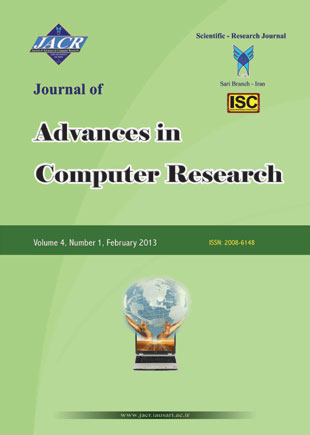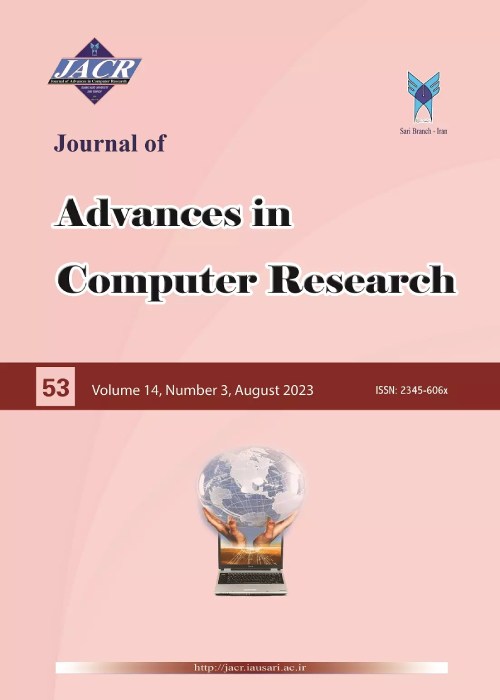فهرست مطالب

Journal of Advances in Computer Research
Volume:4 Issue: 1, Winter 2013
- تاریخ انتشار: 1392/05/10
- تعداد عناوین: 8
-
Pages 1-12Cooperation is the foundation of many protocols in wireless networks. Without cooperation, the performance of a network significantly decreases. Hence, all nodes in traditional networks are required to cooperate with each other. In this paper, instead of traditional networks, a network of rational and autonomous nodes is considered, which means that each node itself can decide whether to cooperate with its neighbor or not and performs something that benefits it. We have used Alternative Prisoner’s Dilemma game which is one of the classic games in the field of game theory, to model node''s behavior in a nontraditional network. Then, by providing an approach based on Learning Automata, we''ve tried to encourage the nodes to cooperate with each other.Keywords: Wireless Network, Cooperation, game theory, Prisoner's Dilemma, APD Game
-
Pages 13-29Task graph scheduling is a multi-objective optimization and NP-hard problem. In this paper a new algorithm on homogeneous multiprocessors systems is proposed. Basically, scheduling algorithms are targeted to balance the two parameters of time and energy consumption. These two parameters are up to a certain limit in contrast with each other and improvement of one causes reduction in the other one. The problem is to achieve the trade-off between these two parameters. Pre-scheduling algorithms are mainly aimed at modifying the structure of task graph to gain optimal scheduling. In the proposed algorithm the suitable number of processors for scheduling the task graph is computed. The idea of Nash equilibrium is mainly applied to compute the appropriate number of processors in such a way that the idle time of the processors is reduced while their processing power is increased. Also, considering the communication costs and interdependencies, the tasks are merged as their earliest start time is reduced. In this way, the length of the critical path is reduced while the degree of parallelism is increased and ultimately the completion time is reduced.Our experimental result on a number of known benchmark graphs demonstrates the effect of our proposed algorithm.Keywords: schedule, pre, schedule, task graph, game theory, Optimization, Nash equilibrium
-
Pages 31-38Active Queue Management (AQM) plays an important role in the Internet congestion control. It tries to enhance congestion control, and to achieve tradeoff between bottleneck utilization and delay. Random Early Detection (RED) is the most popular active queue management algorithm that has been implemented in the in Internet routers and is trying to supply low delay and low packet loss. RED algorithm uses only the average queue length as a congestion meter to trigger packet dropping or packet marking as a congestion feedback. Since the average queue length considers only long–term behavior of any queue, this approach fails to see instantaneous changes of the queue length and hence its reaction is not fast enough. This paperincludes another meter i.e. queue length growth velocity to measure congestion level in the router. This leads to fast reaction to the congestion and hence improves the network performance. Simulation results show that the proposed algorithm outperforms RED algorithm in terms of number of dropped packets and bottleneck utilization.Keywords: Congestion control, active queue management, Random Early Detection, packet dropping, utilization
-
Pages 39-53This paper presents a new Modified Shuffled Frog Leaping Algorithm (MSFLA) applied to design simultaneous coordinated tuning of damping controllers to damp the power system low frequency oscillations. For this, a new frog leaping rule is proposed to improve the local exploration and performance of the original SFLA and the genetic mutation operator is employed for new frog generation instead of random frog generation to improve the performance and quicker algorithm convergence. In order to verify the effectiveness of the proposed method, a 2-area-4-machine and a 5-area-16-machine power system are considered which two power system stabilizers (PSSs) are designed coordinately for the first system and one PSS for a generator and one supplementary controller for a Static Var Compensator (SVC) are designed simultaneously for the second system. To show the effectiveness of the designed controllers, study systems are tested under two different operating conditions and simulation studies are presented.Keywords: Shuffled Frog Leaping Algorithm, Low frequency Oscillation, SVC
-
Pages 55-63Fuzzy groups and fuzzy theory have a lot of applications in several sciences such as mathematics, computer science, computer and electrical engineering. Hence, counting the number of fuzzy subgroups of finite groups to classify them is an important issue in fuzzy theory. The Main goal of this paper is to give an explicit formula for the number of fuzzy subgroups of a finite cyclic group G Z p1 Z p 2 Z p 3 Z pk = ´ ´ ´´, where k p, p, ..., p 1 2 are distinct prime numbers. We introduce a very simple recursive formula to count the number of subgroups of G.Keywords: Fuzzy groups, Lattice, Finite cyclic groups, Chains
-
Pages 65-80Intrusion detection in wireless networks has been a challenging research problem in network security for more than half a century. This paper presents a novel intrusion detection method based on Received Signal Strength Acceptance Test (RSSAT) to improve the IDS capabilities in anomaly-based Host-based Intrusion Detection Systems (HIDS). The new system can identify suspicious behaviors detecting anomalies in the received signal strength from the access points. Several scenarios are implemented in Omnet++ environment to evaluate the performance of the proposed scheme. A test criterion is used to improve accuracy in detecting forged signal powers and at the same time to reduce number of the false positives i.e. number of false attack alerts resulted from the legitimate signal powers.Keywords: Intrusion Detection System, Wireless, WIDS, Security
-
Pages 81-88Reversible logic circuits have found emerging attentions in nanotechnology, optical computing, quantum computing and low power design. A programmable logic array (PLA) is a universal circuit which is used to implement combinational logic circuits. The main part of a PLA is its AND array. In this study we propose two types of optimized reversible programmable logic array (RPLA) circuits. The first type is based on a “2-to-4” AND array, and is proposed for the first time. The second type is based on a “3-to-8” AND array. For each type, we bring some different designs. These circuits are compared with the existing counterparts in terms of number of constant inputs and garbage outputs, delay and the quantum cost and are shown that all parameters in proposed circuits are improved.Keywords: Optimization, Reversible logic, PLA, Genetic Algorithm
-
Pages 89-100The capacitated clustering problem (CCP) is one of the most important combinational optimization problems that nowadays has many real applications in industrial and service problems. In the CCP, a given n nodes with known demands must be partitioned into k distinct clusters in which each cluster is detailed by a node acting as a cluster center of this cluster. The objective is to minimize the sum of distances from all cluster centers to all other nodes in their cluster, such that the sum of the corresponding node weights does not exceed a fixed capacity and every node is allocated to exactly one cluster. This paper presents a hybrid three-phase meta-heuristic algorithm (HTMA) including sweep algorithm (SA), ant colony optimization (ACO) and two local searches for the CCP. At the first step, a feasible solution of CCP is produced by the SA, and at the second step, the ACO, insert and swap moves are used to improve solutions. Extensive computational tests on standard instances from the literature confirm the effectiveness of the presented approach compared to other meta-heuristic algorithms.Keywords: Capacitated Clustering Problem, NP, hard Problems, Ant Colony Optimization, Sweep Algorithm, Local Search


